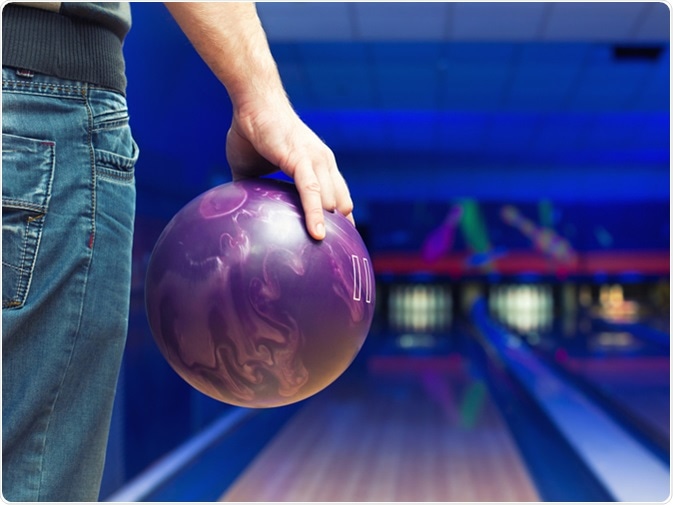By Nita Sharma Das, PhD, MD
The first case of Bowler’s thumb was reported by Siegel in the year 1965. The term 'Bowler’s thumb', as the name depicts, happens to the bowlers due to an extended period of bowling. Sometimes the act of differently throwing the ball causes chronic tension build-up in the ulnar digital nerve.
Although predominantly found in bowlers, this condition can sometimes occur in baseball players, cherry pitters, jewelers, and massage therapists, other than the bowlers, due to occupational requirement for excessive pressure on the digital nerves.

Bowler's thumb most commonly appears in bowlers, hence the name. Image Credit: Nomad_Soul / Shutterstock
Pathophysiology of Bowler’s thumb
The ulnar digital nerve is the most common peripheral nerve that gets affected when using the thumb for gripping hard objects. The extended period of tightly holding the bowling ball with the thumb causes tension build-up. A repetition of such activity leads to chronic tension, which further irritates the nerve. This can lead to traction neuritis and neuroma.
In normal physiological conditions, the ulnar digital nerve is flexible during hand and wrist joint movements like any other peripheral nerves. Any such nerves including the ulnar digital nerve can possibly be elongated due to the presence of a gliding apparatus that is surrounded by peripheral nerves. Therefore, the nerve elongation stress can be tolerable to some extent.
The epineurium and perineurium structures and fascicles underlying the innermost part of the nerve can also be elongated. The perineural and intraneural vascular structures also get stretched during joint movements, which induce strain in the vessels and restrict blood flow. However, in normal condition, healthy gliding system present around the peripheral nerves prevent excessive stress in the nerve tissue and support sufficient blood flow into the axons and nerve cells.
The bowler’s thumb disorder is the outcome of recurrent compression in the ulnar digital nerve, which causes constant tension build-up. This leads to a scar formation in the affected nerve and impair the gliding system. Gradually, the nerve scar also degenerates fascicles. The fibrous element present in the ulnar nerve become thickened due to repeated friction and forms perineural fibrosis. The fibrosis can invade fascicles.
The fibrotic nerve tissue development, which induce neurological symptoms caused by a nerve injury is termed as neuritis. Fibrotic nerve tissue can also reduce vascularization in the inner structure of the nerves and can cause neuronal ischemia in the involved fascicles.
In continuity, this condition degenerates the distressed axon and subsequently leads to the formation of neuroma in certain cases. Pain and numbness are common complaints of an affected individual. The pain can even continue at the resting mode, especially in the case of neuroma development.
Common causes of Bowler’s thumb
There are several unique bowling styles that require a much more powerful delivery. These deliveries or uncommon maneuvers often cause incorrect biomechanical hand muscle and wrist joint movements. Furthermore, the upper limb acquires a huge stress and strain, which hampers normal nerve elongation during movement and impairs the gliding system.
Pin bowlers often gets affected with Bowler’s thumb, as this specific type of bowling requires putting the thumb into a hole in the bowl. Continuous repetition of such activity causes fibrosis development around the nerve. Some bowlers may also develop a chronic proliferative synovitis at the flexor pollicis longus tendon.
Beyond bowling, some other activities may also trigger compression in the ulnar digital nerve. Massage therapists, jewelers or cherry pitters can also develop the same condition due to their occupations, as the sensory nerve present in the callus or adventitious bursa are very much vulnerable to pressure generation. All these occupations produce minimum pressure build-up repetitively. This repetitive pressure may cause neuroma formation.
Notably, an acute condition may occur with similar symptoms after a single episode of bowling. This condition is associated with neurapraxia or axonotmesis and can be resolved spontaneously within few months. Bowling thumb, on the other hand, is caused by scarring and fibrosis which do not resolve spontaneously.
Bowler’s Thumb
References
Reviewed by: Antonia Stanojević, BA, MA
Further Reading
Last Updated: Jan 26, 2021